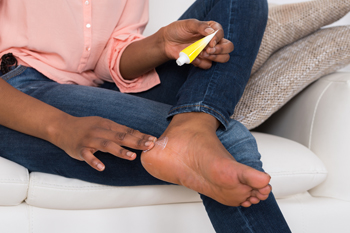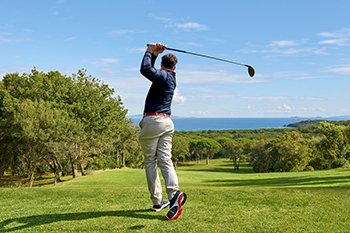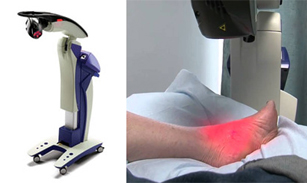
(908) 381-8160Berkeley Heights

People who have flat feet often look toward stretching and exercising which may help any discomfort that can accompany this ailment. Flat feet are defined as the foot having a low arch, or the arch being absent. It is noticeable while standing on the floor, and the entire foot lies flat. It is considered to be an imbalance, and can affect other parts of the body. The feet are the foundation of the body, and carry us through the day. When the feet connect to the ground, and there is no arch, the plantar fascia may be negatively affected, and may cause pain and discomfort. This is the band of tissue that runs across the bottom of the foot, and connects the heel to the toes. This can produce tight calf muscles. There are simple stretches that can help to relieve the discomfort. These can consist of standing on a step and lowering the heels one at a time until a gentle stretch is felt. Additionally, many people choose to roll the sole of their foot over a tennis ball, and this can be beneficial in releasing any tension in the foot. If you have flat feet, and would like to learn more about how stretches can help you, please consult with a podiatrist.
Flatfoot is a condition many people suffer from. If you have flat feet, contact Dr. Janet Leicht from New Jersey. Our doctor will treat your foot and ankle needs.
What Are Flat Feet?
Flatfoot is a condition in which the arch of the foot is depressed and the sole of the foot is almost completely in contact with the ground. About 20-30% of the population generally has flat feet because their arches never formed during growth.
Conditions & Problems:
Having flat feet makes it difficult to run or walk because of the stress placed on the ankles.
Alignment – The general alignment of your legs can be disrupted, because the ankles move inward which can cause major discomfort.
Knees – If you have complications with your knees, flat feet can be a contributor to arthritis in that area.
Symptoms
Treatment
If you are experiencing pain and stress on the foot you may weaken the posterior tibial tendon, which runs around the inside of the ankle.
If you have any questions please feel free to contact our office located in Berkeley Heights, NJ . We offer the newest diagnostic and treatment technologies for all your foot and ankle needs.

Cracked heels are an unsightly and unattractive affliction of the foot that primarily affects the skin surrounding the heels. If you have cracked heels, you might notice that the skin on the heels has become very dry and hard calluses have started to form. Although there are many potential causes of cracked heels, wearing flip flops or sandals without a back strap could be contributing to this problem. Despite the fact that these shoes can be convenient to wear during the summer time, they effectively expose your heels to the air in such a way that can dry out the skin, making cracked heels more likely. Additionally, the fact that these shoes offer little arch or heel support cushioning is problematic. The lack of cushioning forces the individual to exert more pressure on their feet when walking, sometimes causing the skin to break or crack. One simple way of preventing this from happening is by choosing to wear shoes that cover more of the skin on the foot, as opposed to flip flops or open-back sandals. Wearing shoes that cover more skin will provide the skin on the heel with the coverage that it needs to be protected. You might even consider preventing cracked heels by applying a daily moisturizer and drinking plenty of water to stay hydrated. If you wear flip flops or sandals, consider contacting a podiatrist to learn more about your risk of developing cracked heels.
Cracked heels are unsightly and can cause further damage to your shoes and feet. If you have any concerns, contact Dr. Janet Leicht from New Jersey. Our doctor can provide the care you need to keep you pain-free and on your feet.
Cracked Heels
Cracked heels appear unappealing and can make it harder for you walk around in sandals. Aside from looking unpleasant, cracked heels can also tear stockings, socks, and wear out your shoes. There are several methods to help restore a cracked heel and prevent further damage.
How Do You Get Them?
Dry skin is the number one culprit in creating cracked heels. Many athletes, walkers, joggers, and even swimmers suffer from cracked heels. Age and skin oil production play a role to getting cracked heels as well.
Promote Healing
Over the counter medicines can help, especially for those that need instant relief or who suffer from chronic dry feet.
Wear Socks – Wearing socks with medicated creams helps lock in moisture.
Moisturizers – Applying both day and night will help alleviate dryness which causes cracking.
Pumice Stones – These exfoliate and remove dead skin, which allows for smoother moisturizer application and better absorption into the skin.
Change in Diet
Eating healthy with a well-balanced diet will give the skin a fresh and radiant look. Your body responds to the kinds of food you ingest. Omega-3 fatty acids and zinc supplements can also revitalize skin tissue.
Most importantly, seek professional help if unsure how to proceed in treating cracked heels. A podiatrist will help you with any questions or information needed.
If you have any questions, please feel free to contact our office located in Berkeley Heights, NJ . We offer the newest diagnostic and treatment technologies for all your foot care needs.

Regardless of your level of fitness or skill, or how often you play, you may experience an injury at some point while playing golf. Golf injuries can occur throughout the body, including the feet and ankles. The feet are critical to providing the necessary power and balance required as the body goes through the mechanics of the golf swing. Losing your footing, trying to strike the ball while balancing on an uneven surface, or having poor form while swinging may all contribute to injuries in the feet. Other golf injuries in the feet include ankle sprains, tendinitis, inflammation, and even blisters. You can help protect your feet and ankles while playing golf by improving your swinging form and wearing golf shoes that fit properly. To keep your feet and ankles in top form, or to learn more about how biomechanics can affect your game, make an appointment with a podiatrist.
Sports related foot and ankle injuries require proper treatment before players can go back to their regular routines. For more information, contact Dr. Janet Leicht of New Jersey. Our doctor can provide the care you need to keep you pain-free and on your feet.
Sports Related Foot and Ankle Injuries
Foot and ankle injuries are a common occurrence when it comes to athletes of any sport. While many athletes dismiss the initial aches and pains, the truth is that ignoring potential foot and ankle injuries can lead to serious problems. As athletes continue to place pressure and strain the area further, a mild injury can turn into something as serious as a rupture and may lead to a permanent disability. There are many factors that contribute to sports related foot and ankle injuries, which include failure to warm up properly, not providing support or wearing bad footwear. Common injuries and conditions athletes face, including:
Sports related injuries are commonly treated using the RICE method. This includes rest, applying ice to the injured area, compression and elevating the ankle. More serious sprains and injuries may require surgery, which could include arthroscopic and reconstructive surgery. Rehabilitation and therapy may also be required in order to get any recovering athlete to become fully functional again. Any unusual aches and pains an athlete sustains must be evaluated by a licensed, reputable medical professional.
If you have any questions please feel free to contact our office located in Berkeley Heights, NJ . We offer the newest diagnostic and treatment technologies for all your foot and ankle needs.

People who are infected with toenail fungus can be embarrassed to wear flip-flops and sandals in the warmer months. It is an unsightly foot condition that leaves the nails yellowed and thickened and in severe cases, brittle. Additionally, the toes can itch or turn black, and may often be accompanied by athlete’s foot. There are a variety of remedies for toenail fungus, including laser treatment. This consists of using a laser to target and destroy the nail fungus without damaging the surrounding skin or nail. Research has indicated there is generally no risk, and most patients do not have side effects. The 10-minute per toenail sessions are typically painless and have a high percentage rate for successful fungal removal. If you have toenail fungus and are interested in this type of treatment, it is strongly advised that you consult with a podiatrist.
Laser treatment can be an effective way to get rid of toenail fungus. If you have any questions about laser treatment, consult with Dr. Janet Leicht from New Jersey. Our doctor will assess your condition and provide you with quality treatment for fungal nails.
What Are Toenail Fungal Infections?
Onychomycosis, or fungal infection of the nail, is a relatively common and non-serious condition. Around 10 percent of U.S. citizens are afflicted with fungal nails. Common forms of fungus that infect the nail include dermatophytes, yeasts, and molds.
Symptoms of Toenail Fungal Infections Include:
Diagnosis for Fungal Nails
Fungal infections are diagnosed by fungal culture and microscopy. This will rule out any other conditions such as nail trauma, psoriasis, lichen planus, and onychogryphosis.
What Is Laser Treatment?
Laser treatment is a non-invasive, safe, quick, and painless procedure that uses the heat from a laser to kill fungus in the nail. Each infected nail is targeted with a laser for several minutes. The treatment is usually utilized several different times over a select period. During this time, a podiatrist will keep an eye on the infection.
If you have any questions, please feel free to contact our office located in Berkeley Heights, NJ . We offer the newest diagnostic and treatment technologies for all your foot care needs.

A common form of ankle pain is called posterior tibial tendonitis. This tendon helps to stabilize the foot and is approximately the thickness of a pencil. It contributes to supporting the foot and maintaining the arch. The common symptoms that are associated with this condition are sharp pains along the inner part of the ankle, stiffness, and the ankle can be sore when touched. People who enjoy running may realize it is almost impossible to pursue, and care is often sought so running can be resumed. Research has shown there are four stages of this type of ankle pain. Tendon damage and inflammation are typical in stage one, and the foot retains its normal shape. In stage two, the arch can flatten, and heel raises will be difficult to perform. The tendon can partially or fully rupture in stages three and four, and this may lead to permanent deformities in the foot and ankle. The recovery process can start with possibly using orthotics in the beginning stages, and stages three and four may require surgery. If you have endured this type of injury, it is strongly suggested that you are under the care of a podiatrist who can effectively treat this condition.
Ankle pain can have many different causes and the pain may potentially be serious. If you have ankle pain, consult with Dr. Janet Leicht from New Jersey. Our doctor will assess your condition and provide you with quality foot and ankle treatment.
Ankle pain is any condition that causes pain in the ankle. Due to the fact that the ankle consists of tendons, muscles, bones, and ligaments, ankle pain can come from a number of different conditions.
Causes
The most common causes of ankle pain include:
Symptoms
Symptoms of ankle injury vary based upon the condition. Pain may include general pain and discomfort, swelling, aching, redness, bruising, burning or stabbing sensations, and/or loss of sensation.
Diagnosis
Due to the wide variety of potential causes of ankle pain, podiatrists will utilize a number of different methods to properly diagnose ankle pain. This can include asking for personal and family medical histories and of any recent injuries. Further diagnosis may include sensation tests, a physical examination, and potentially x-rays or other imaging tests.
Treatment
Just as the range of causes varies widely, so do treatments. Some more common treatments are rest, ice packs, keeping pressure off the foot, orthotics and braces, medication for inflammation and pain, and surgery.
If you have any questions, please feel free to contact our office located in Berkeley Heights, NJ . We offer the newest diagnostic and treatment technologies for all your foot care needs.